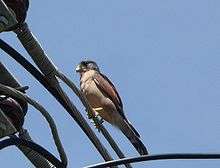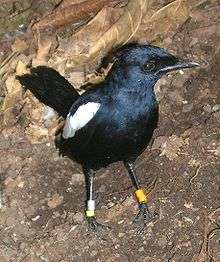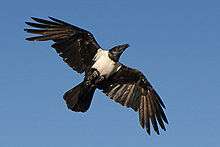List of birds of Seychelles
This is a list of the bird species recorded in the Seychelles. It includes a total of 238 species. However, a total of 278 species have been accepted by Seychelles Bird Records Committee (SBRC) as recorded in Seychelles up to 1 January 2020. This total includes 277 species per the The Clements Checklist of Birds of the World plus yellow-billed kite, currently treated by Clements as a subspecies of black kite, which has also been recorded in Seychelles. Fourteen extant species are endemic. Ten have been introduced by humans although the Madagascar fody is possibly native. Of these 139 (or 178 as per the SBRC list of 1 January 2020) are rare or accidental. Seven species listed (ten per SBRC) are extirpated in the Seychelles. Sixteen species are globally threatened.
This list's taxonomic treatment (designation and sequence of orders, families and species) and nomenclature (common and scientific names) follow the conventions of The Clements Checklist of Birds of the World, 6th edition. The family accounts at the beginning of each heading reflect this taxonomy, as do the species counts found in each family account. Introduced and accidental species are included in the total counts for the Seychelles.
The following tags have been used to highlight several categories. The commonly occurring native species do not fall into any of these categories.
- (A) Accidental - a species that rarely or accidentally occurs in the Seychelles
- (E) Endemic - a species endemic to the Seychelles
- (I) Introduced - a species introduced to the Seychelles as a consequence, direct or indirect, of human actions
- (Ex) Extirpated - a species that no longer occurs in the Seychelles although populations exist elsewhere
Grebes
Order: Podicipediformes Family: Podicipedidae
Grebes are small to medium-large freshwater diving birds. They have lobed toes and are excellent swimmers and divers. However, they have their feet placed far back on the body, making them quite ungainly on land. There are 20 species worldwide and 1 species which occurs in the Seychelles.
- Eared grebe, Podiceps nigricollis (A)
Shearwaters and petrels
Order: Procellariiformes Family: Procellariidae
The procellariids are the main group of medium-sized "true petrels", characterised by united nostrils with medium septum and a long outer functional primary.
- Antarctic giant petrel, Macronectes giganteus (A)
- Cape petrel, Daption capense (A)
- Kermadec petrel, Pterodroma neglecta (A)
- Jouanin's petrel, Bulweria fallax (A)
- Flesh-footed shearwater, Ardenna carneipes (A)
- Wedge-tailed shearwater, Ardenna pacificus
- Tropical shearwater, Puffinus bailloni
Austral storm petrels
Order: Procellariiformes Family: Oceanitidae
The storm petrels are relatives of the petrels and are the smallest seabirds. They feed on planktonic crustaceans and small fish picked from the surface, typically while hovering. The flight is fluttering and sometimes bat-like.
- Wilson's storm petrel, Oceanites oceanicus (A)
- White-faced storm petrel, Pelagodroma marina (A)
Northern storm petrels
Order: Procellariiformes Family: Hydrobatidae
- Swinhoe's storm petrel, Oceanodroma monorhis (A)
- Matsudaira's storm petrel, Oceanodroma matsudairae (A)
Tropicbirds
Order: Phaethontiformes Family: Phaethontidae
Tropicbirds are slender white birds of tropical oceans, with exceptionally long central tail feathers. Their heads and long wings have black markings.
- Red-billed tropicbird, Phaethon aethereus (A)
- Red-tailed tropicbird, Phaethon rubricauda
- White-tailed tropicbird, Phaethon lepturus
Boobies and gannets
Order: Suliformes Family: Sulidae
The sulids comprise the gannets and boobies. Both groups are medium to large coastal seabirds that plunge-dive for fish. There are 9 species worldwide and 4 species which have been recorded in Seychelles, one of which is extinct.
- Abbott's booby, Sula abbotti (Ex)
- Masked booby, Sula dactylatra
- Red-footed booby, Sula sula
- Brown booby, Sula leucogaster
Cormorants
Order: Suliformes Family: Phalacrocoracidae
Phalacrocoracidae is a family of medium to large coastal, fish-eating seabirds that includes cormorants and shags. Plumage colouration varies, with the majority having mainly dark plumage, some species being black-and-white and a few being colourful.
- Great cormorant, Phalacrocorax carbo (A)
- Long-tailed cormorant, Microcarbo africanus (A)
Frigatebirds
Order: Suliformes Family: Fregatidae
Frigatebirds are large seabirds usually found over tropical oceans. They are large, black-and-white or completely black, with long wings and deeply forked tails. The males have coloured inflatable throat pouches. They do not swim or walk and cannot take off from a flat surface. Having the largest wingspan-to-body-weight ratio of any bird, they are essentially aerial, able to stay aloft for more than a week.
- Great frigatebird, Fregata minor
- Lesser frigatebird, Fregata ariel
Pelicans
Order: Pelecaniformes Family: Pelecanidae
Pelicans are large water birds with a distinctive pouch under their beak. As with other members of the order Pelecaniformes, they have webbed feet with four toes. There are 8 species worldwide and 1 species which formerly occurred in the Seychelles.
- Pink-backed pelican, Pelecanus rufescens (Ex)
Bitterns, herons and egrets
Order: Pelecaniformes Family: Ardeidae
The family Ardeidae contains the bitterns, herons and egrets. Herons and egrets are medium to large wading birds with long necks and legs. Bitterns tend to be shorter necked and more wary. Members of Ardeidae fly with their necks retracted, unlike other long-necked birds such as storks, ibises and spoonbills.
- Grey heron, Ardea cinerea
- Purple heron, Ardea purpurea (A)
- Great egret, Ardea alba (A)
- Intermediate egret, Ardea intermedia (A)
- Little egret, Egretta garzetta (A)
- Dimorphic egret, Egretta (garzetta) dimorpha
- Squacco heron, Ardeola ralloides (A)
- Indian pond heron, Ardeola grayii (A)
- Madagascar pond heron, Ardeola idae
- Cattle egret, Bubulcus ibis
- Striated heron, Butorides striata
- Black-crowned night heron, Nycticorax nycticorax
- Yellow bittern, Ixobrychus sinensis
- Cinnamon bittern, Ixobrychus cinnamomeus (A)
- Great bittern, Botaurus stellaris (A)
Storks
Order: Ciconiiformes Family: Ciconiidae
Storks are large, long-legged, long-necked, wading birds with long, stout bills. Storks are mute, but bill-clattering is an important mode of communication at the nest. Their nests can be large and may be reused for many years. Many species are migratory. There are 19 species worldwide and 1 species which occurs in the Seychelles.
- White stork, Ciconia ciconia (A)
Ibises and spoonbills
Order: Pelecaniformes Family: Threskiornithidae
Threskiornithidae is a family of large terrestrial and wading birds which includes the ibises and spoonbills. They have long, broad wings with 11 primary and about 20 secondary feathers. They are strong fliers and despite their size and weight, very capable soarers.
- Malagasy sacred ibis, Threskiornis bernieri
- Glossy ibis, Plegadis falcinellus (A)
Flamingos
Order: Phoenicopteriformes Family: Phoenicopteridae
Flamingos are gregarious wading birds, usually 3 to 5 feet (0.9 to 1.5 m) tall, found in both the Western and Eastern Hemispheres. Flamingos filter-feed on shellfish and algae. Their oddly shaped beaks are specially adapted to separate mud and silt from the food they consume and, uniquely, are used upside-down. There are 6 species worldwide and 1 species which occurs in the Seychelles.
- Greater flamingo, Phoenicopterus roseus
Ducks, geese and swans
Order: Anseriformes Family: Anatidae
Anatidae includes the ducks and most duck-like waterfowl, such as geese and swans. These birds are adapted to an aquatic existence with webbed feet, flattened bills, and feathers that are excellent at shedding water due to an oily coating.
- White-faced whistling duck, Dendrocygna viduata (A)
- Ruddy shelduck, Tadorna ferruginea (A)
- Eurasian wigeon, Mareca penelope (A)
- Mallard, Anas platyrhynchos (A)
- Northern pintail, Anas acuta (A)
- Garganey, Spatula querquedula
- Northern shoveler, Spatula clypeata (A)
- Ferruginous pochard, Aythya nyroca (A)
- Muscovy duck, Cairina moschata
Osprey
Order: Accipitriformes Family: Pandionidae
The family Pandionidae contains only one species, the osprey. The osprey is a medium-large raptor which is a specialist fish-eater with a worldwide distribution.
- Osprey, Pandion haliaetus (A)
Hawks, kites and eagles
Order: Accipitriformes Family: Accipitridae
Accipitridae is a family of birds of prey, which includes hawks, eagles, kites, harriers and Old World vultures. These birds have powerful hooked beaks for tearing flesh from their prey, strong legs, powerful talons and keen eyesight.
- European honey buzzard, Pernis apivorus (A)
- Black kite, Milvus migrans (A)
- Yellow-billed kite, Milvus (migrans) aegyptius (A)
- Western marsh harrier, Circus aeruginosus (A)
- Pallid harrier, Circus macrourus (A)
- Booted eagle, Hieraaetus pennatus (A)
Falcons
Order: Falconiformes Family: Falconidae
Falconidae is a family of diurnal birds of prey. They differ from hawks, eagles and kites in that they kill with their beaks instead of their talons.
- Lesser kestrel, Falco naumanni (A)
- Madagascar kestrel, Falco newtoni
- Seychelles kestrel, Falco araea (E)
- Red-footed falcon, Falco vespertinus (A)
- Amur falcon, Falco amurensis (A)
- Eleonora's falcon, Falco eleonorae (A)
- Sooty falcon, Falco concolor (A)
- Eurasian hobby, Falco subbuteo (A)
- Saker falcon, Falco cherrug (A)
- Peregrine falcon, Falco peregrinus (A)
Pheasants and partridges
Order: Galliformes Family: Phasianidae
The Phasianidae are a family of terrestrial birds which consists of quails, partridges, snowcocks, francolins, spurfowls, tragopans, monals, pheasants, peafowls and jungle fowls. In general, they are plump (although they vary in size) and have broad, relatively short wings. There are 156 species worldwide and 2 species which occur in the Seychelles.
- Grey francolin, Francolinus pondicerianus (I)
- Common quail, Coturnix coturnix (A)
Rails, crakes, gallinules and coots
Order: Gruiformes Family: Rallidae
Rallidae is a large family of small to medium-sized birds which includes the rails, crakes, coots and gallinules. Typically they inhabit dense vegetation in damp environments near lakes, swamps or rivers. In general they are shy and secretive birds, making them difficult to observe. Most species have strong legs and long toes which are well adapted to soft uneven surfaces. They tend to have short, rounded wings and to be weak fliers. There are 143 species worldwide and 9 species which occur in the Seychelles.
- White-throated rail, Dryolimnas cuvieri
- Corn crake, Crex crex (A)
- White-breasted waterhen, Amaurornis phoenicurus (A)
- Little crake, Porzana parva (A)
- Spotted crake, Porzana porzana (A)
- Striped crake, Aenigmatolimnas marginalis (A)
- African swamphen, Porphyrio madagascariensis (Ex)
- Allen's gallinule, Porphyrio alleni (A)
- Common moorhen, Gallinula chloropus
Crab-plover
Order: Charadriiformes Family: Dromadidae
The crab-plover is related to the waders. It resembles a plover but with very long grey legs and a strong heavy black bill similar to a tern. It has black-and-white plumage, a long neck, partially webbed feet and a bill designed for eating crabs.
- Crab-plover, Dromas ardeola
Oystercatchers
Order: Charadriiformes Family: Haematopodidae
The oystercatchers are large and noisy plover-like birds, with strong bills used for smashing or prising open molluscs. There are 11 species worldwide and 1 species which occurs in the Seychelles.
- Eurasian oystercatcher, Haematopus ostralegus (A)
Avocets and stilts
Order: Charadriiformes Family: Recurvirostridae
Recurvirostridae is a family of large wading birds, which includes the avocets and stilts. The avocets have long legs and long up-curved bills. The stilts have extremely long legs and long, thin, straight bills. There are 9 species worldwide and 1 species which occurs in the Seychelles.
- Black-winged stilt, Himantopus himantopus (A)
Thick-knees
Order: Charadriiformes Family: Burhinidae
The thick-knees are a group of largely tropical waders in the family Burhinidae. They are found worldwide within the tropical zone, with some species also breeding in temperate Europe and Australia. They are medium to large waders with strong black or yellow-black bills, large yellow eyes and cryptic plumage. Despite being classed as waders, most species have a preference for arid or semi-arid habitats. There are 9 species worldwide and 1 species which occurs in the Seychelles.
- Eurasian thick-knee, Burhinus oedicnemus (A)
Pratincoles and coursers
Order: Charadriiformes Family: Glareolidae
Glareolidae is a family of wading birds comprising the pratincoles, which have short legs, long pointed wings and long forked tails, and the coursers, which have long legs, short wings and long, pointed bills which curve downwards. There are 17 species worldwide and 4 species which occur in the Seychelles.
- Collared pratincole, Glareola pratincola (A)
- Oriental pratincole, Glareola maldivarum (A)
- Black-winged pratincole, Glareola nordmanni (A)
- Madagascar pratincole, Glareola ocularis (A)
Plovers and lapwings
Order: Charadriiformes Family: Charadriidae
The family Charadriidae includes the plovers, dotterels and lapwings. They are small to medium-sized birds with compact bodies, short, thick necks and long, usually pointed, wings. They are found in open country worldwide, mostly in habitats near water. There are 66 species worldwide and 9 species which occur in the Seychelles.
- Sociable lapwing, Vanellus gregarius (A)
- Pacific golden plover, Pluvialis fulva
- Black-bellied plover, Pluvialis squatarola
- Common ringed plover, Charadrius hiaticula
- Little ringed plover, Charadrius dubius (A)
- Lesser sandplover, Charadrius mongolus
- Greater sandplover, Charadrius leschenaultii
- Caspian plover, Charadrius asiaticus (A)
- Oriental plover, Charadrius veredus (A)
Sandpipers and allies
Order: Charadriiformes Family: Scolopacidae
Scolopacidae is a large diverse family of small to medium-sized shorebirds including the sandpipers, curlews, godwits, shanks, tattlers, woodcocks, snipes, dowitchers and phalaropes. The majority of these species eat small invertebrates picked out of the mud or soil. Variation in length of legs and bills enables multiple species to feed in the same habitat, particularly on the coast, without direct competition for food.
- Pintail snipe, Gallinago stenura (A)
- Great snipe, Gallinago media (A)
- Common snipe, Gallinago gallinago (A)
- Black-tailed godwit, Limosa limosa (A)
- Bar-tailed godwit, Limosa lapponica
- Little curlew, Numenius minutus (A)
- Whimbrel, Numenius phaeopus
- Eurasian curlew, Numenius arquata
- Spotted redshank, Tringa erythropus (A)
- Common redshank, Tringa totanus (A)
- Marsh sandpiper, Tringa stagnatilis (A)
- Common greenshank, Tringa nebularia
- Green sandpiper, Tringa ochropus (A)
- Wood sandpiper, Tringa glareola
- Grey-tailed tattler, Tringa brevipes (A)
- Terek sandpiper, Xenus cinereus
- Common sandpiper, Actitis hypoleucos
- Ruddy turnstone, Arenaria interpres
- Great knot, Calidris tenuirostris (A)
- Sanderling, Calidris alba
- Little stint, Calidris minuta
- Temminck's stint, Calidris temminckii (A)
- Long-toed stint, Calidris subminuta (A)
- Pectoral sandpiper, Calidris melanotos (A)
- Sharp-tailed sandpiper, Calidris acuminata (A)
- Curlew sandpiper, Calidris ferruginea
- Broad-billed sandpiper, Calidris falcinellus (A)
- Buff-breasted sandpiper, Calidris subruficollis (A)
- Ruff, Calidris pugnax (A)
- Red-necked phalarope, Phalaropus lobatus (A)
Skuas and jaegers
Order: Charadriiformes Family: Stercorariidae
The family Stercorariidae are, in general, medium to large birds, typically with grey or brown plumage, often with white markings on the wings. They nest on the ground in temperate and arctic regions and are long-distance migrants. There are 7 species worldwide and 3 species which occur in the Seychelles.
- South polar skua, Stercorarius maccormicki (A)
- Brown skua, Stercorarius antarctica
- Parasitic jaeger, Stercorarius parasiticus (A)
Gulls, terns, and skimmers
Order: Charadriiformes Family: Laridae
Laridae is a family of medium to large seabirds, the gulls, terns, and skimmers. Gulls are typically grey or white, often with black markings on the head or wings. They have stout, longish bills and webbed feet. Terns are a group of generally medium to large seabirds typically with grey or white plumage, often with black markings on the head. Most terns hunt fish by diving but some pick insects off the surface of fresh water. Terns are generally long-lived birds, with several species known to live in excess of 30 years.
- Lesser black-backed gull, Larus fuscus (A)
- Heuglin's gull, Larus heuglini (A)
- Black-headed gull, Chroicocephalus ridibundus (A)
- Gull-billed tern, Gelochelidon nilotica
- Caspian tern, Hydroprogne caspia
- Lesser crested tern, Thalasseus bengalensis
- Sandwich tern, Thalasseus sandvicensis (A)
- Great crested tern, Thalasseus bergii
- Roseate tern, Sterna dougallii
- Black-naped tern, Sterna sumatrana
- Common tern, Sterna hirundo
- White-cheeked tern, Sterna repressa (A)
- Little tern, Sternula albifrons (A)
- Saunders's tern, Sternula saundersi
- Bridled tern, Onychoprion anaethetus
- Sooty tern, Onychoprion fuscatus
- Whiskered tern, Chlidonias hybrida (A)
- White-winged tern, Chlidonias leucopterus
- Lesser noddy, Anous tenuirostris
- Brown noddy, Anous stolidus
- White tern, Gygis alba
Pigeons and doves
Order: Columbiformes Family: Columbidae
Pigeons and doves are stout-bodied birds with short necks and short slender bills with a fleshy cere.
- Rock pigeon, Columba livia (I)
- European turtle dove, Streptopelia turtur (A)
- Malagasy turtle dove, Nesoenas picturatus
- Zebra dove, Geopelia striata (I)
- Comoro blue pigeon, Alectroenas sganzini
- Seychelles blue pigeon, Alectroenas pulcherrimus (E)
Old World parrots
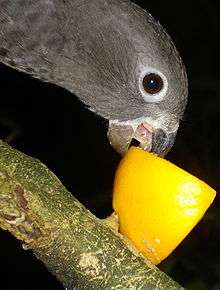
Order: Psittaciformes Family: Psittaculidae
- Seychelles parakeet, Psittacula (eupatria) wardi (E, Ex)
- Rose-ringed parakeet, Psittacula krameri (I, Ex)
- Grey-headed lovebird, Agapornis canus (I, Ex)
- Seychelles black parrot, Coracopsis (nigra) barklyi (E)
Cuckoos
Order: Cuculiformes Family: Cuculidae
The family Cuculidae includes cuckoos, roadrunners and anis. These birds are of variable size with slender bodies, long tails and strong legs. The Old World cuckoos are brood parasites. There are 138 species worldwide and 5 species which occur in the Seychelles.
- Pied cuckoo, Clamator jacobinus (A)
- Great spotted cuckoo, Clamator glandarius (A)
- Common cuckoo, Cuculus canorus (A)
- Lesser cuckoo, Cuculus poliocephalus (A)
- Madagascar coucal, Centropus toulou
Barn owls
Order: Strigiformes Family: Tytonidae
Barn owls are medium to large owls with large heads and characteristic heart-shaped faces. They have long strong legs with powerful talons.
- Barn owl, Tyto alba
Typical owls
Order: Strigiformes Family: Strigidae
The typical owls are small to large solitary nocturnal birds of prey. They have large forward-facing eyes and ears, a hawk-like beak and a conspicuous circle of feathers around each eye called a facial disk.
- Eurasian scops owl, Otus scops
- Seychelles scops owl, Otus insularis (E)
- Verreaux's eagle-owl, Bubo lacteus
- Brown fish owl, Ketupa zeylonensis (A)
Nightjars
Order: Caprimulgiformes Family: Caprimulgidae
Nightjars are medium-sized nocturnal birds that usually nest on the ground. They have long wings, short legs and very short bills. Most have small feet, of little use for walking, and long pointed wings. Their soft plumage is camouflaged to resemble bark or leaves. There are 86 species worldwide and 2 species which occur in the Seychelles.
- Eurasian nightjar, Caprimulgus europaeus (A)
- Madagascar nightjar, Caprimulgus madagascariensis
Swifts
Order: Caprimulgiformes Family: Apodidae
Swifts are small birds which spend the majority of their lives flying. These birds have very short legs and never settle voluntarily on the ground, perching instead only on vertical surfaces. Many swifts have long swept-back wings which resemble a crescent or boomerang. There are 5 species which have been recorded in the Seychelles.
- Seychelles swiftlet, Aerodramus elaphrus (E)
- White-throated needletail, Hirundapus caudacutus (A)
- Common swift, Apus apus (A)
- Pacific swift, Apus pacificus (A)
- Little swift, Apus affinis (A)
Kingfishers
Order: Coraciiformes Family: Alcedinidae
Kingfishers are medium-sized birds with large heads, long, pointed bills, short legs and stubby tails. There are 93 species worldwide and 1 species which occur in the Seychelles.
- Grey-headed kingfisher, Halcyon leucocephala (A)
Bee-eaters
Order: Coraciiformes Family: Meropidae
The bee-eaters are a group of near passerine birds in the family Meropidae. Most species are found in Africa but others occur in southern Europe, Madagascar, Australia and New Guinea. They are characterised by richly coloured plumage, slender bodies and usually elongated central tail feathers. All are colourful and have long downturned bills and pointed wings, which give them a swallow-like appearance when seen from afar. There are 26 species worldwide and 3 species which occur in the Seychelles.
- Blue-cheeked bee-eater, Merops persicus (A)
- Madagascar bee-eater, Merops superciliosus (A)
- European bee-eater, Merops apiaster (A)
Typical rollers
Order: Coraciiformes Family: Coraciidae
Rollers resemble crows in size and build, but are more closely related to the kingfishers and bee-eaters. They share the colourful appearance of those groups with blues and browns predominating. The two inner front toes are connected, but the outer toe is not. There are 12 species worldwide and 2 species which occur in the Seychelles.
- European roller, Coracias garrulus (A)
- Broad-billed roller, Eurystomus glaucurus
Hoopoes
Order: Bucerotiformes Family: Upupidae
Hoopoes have black, white and orangey-pink colouring with a large erectile crest on their head. There are 2 species worldwide and 1 species which occurs in the Seychelles.
- Eurasian hoopoe, Upupa epops (A)
Larks
Order: Passeriformes Family: Alaudidae
Larks are small terrestrial birds with often extravagant songs and display flights. Most larks are fairly dull in appearance. Their food is insects and seeds. There are 91 species worldwide and 2 species which occur in the Seychelles.
- Bimaculated lark, Melanocorypha bimaculata (A)
- Greater short-toed lark, Calandrella brachydactyla (A)
Swallows and martins
Order: Passeriformes Family: Hirundinidae
The family Hirundinidae is adapted to aerial feeding. They have a slender streamlined body, long pointed wings and a short bill with a wide gape. The feet are adapted to perching rather than walking, and the front toes are partially joined at the base. There are 75 species worldwide and 4 species which occur in the Seychelles.
- Sand martin, Riparia riparia (A)
- Mascarene martin, Phedina borbonica (A)
- Barn swallow, Hirundo rustica
- Common house martin, Delichon urbicum (A)
Wagtails and pipits
Order: Passeriformes Family: Motacillidae
Motacillidae is a family of small passerine birds with medium to long tails. They include the wagtails, longclaws and pipits. They are slender, ground feeding insectivores of open country. There are 54 species worldwide and 6 species which occur in the Seychelles.
- White wagtail, Motacilla alba (A)
- Citrine wagtail, Motacilla citreola (A)
- Western yellow wagtail, Motacilla flava (A)
- Grey wagtail, Motacilla cinerea (A)
- Richard's pipit, Anthus richardi (A)
- Tree pipit, Anthus trivialis
- Red-throated pipit, Anthus cervinus (A)
Bulbuls
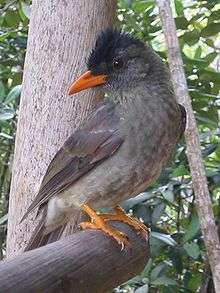
Order: Passeriformes Family: Pycnonotidae
Bulbuls are medium-sized songbirds. Some are colourful with yellow, red or orange vents, cheeks, throats or supercilia, but most are drab, with uniform olive-brown to black plumage. Some species have distinct crests. There are 130 species worldwide and 3 species which occur in the Seychelles. Red-whiskered bulbul, introduced in 1970s, occurred only at Assumption and was eradicated from there in 2014 to maintain introduced bird-free status of nearby Aldabra (birds, discovered at Aldabra were culled in 2013 before they established population). Its current status in Seychelles is extirpated (locally extinct).
- Red-whiskered bulbul, Pycnonotus jocosus (I, Ex)
- Madagascar bulbul, Hypsipetes madagascariensis
- Seychelles bulbul, Hypsipetes crassirostris (E)
Acrocephalid warblers
Order: Passeriformes Family: Acrocephalidae
- Aldabra brush warbler, Nesillas aldabrana (E, Ex)
- Sedge warbler, Acrocephalus schoenobaenus (A)
- Seychelles warbler, Acrocephalus sechellensis (E)
- Icterine warbler, Hippolais icterina (A)
Phylloscopid warblers
Order: Passeriformes Family: Phylloscopidae
- Willow warbler, Phylloscopus trochilus (A)
- Common chiffchaff, Phylloscopus collybita (A)
- Wood warbler, Phylloscopus sibilatrix (A)
Sylviid warblers, parrotbills, and allies
Order: Passeriformes Family: Sylviidae
The family Sylviidae is a group of small insectivorous passerine birds. They mainly occur as breeding species, as the common name implies, in Europe, Asia and, to a lesser extent, Africa. Most are of generally undistinguished appearance, but many have distinctive songs.
- Eurasian blackcap, Sylvia atricapilla (A)
- Greater whitethroat, Sylvia communis (A)
Old World flycatchers
Order: Passeriformes Family: Muscicapidae
Old World flycatchers are a large group of small passerine birds native to the Old World. They are mainly small arboreal insectivores. The appearance of these birds is highly varied, but they mostly have weak songs and harsh calls.
- Common rock thrush, Monticola saxatilis (A)
- Spotted flycatcher, Muscicapa striata (A)
- Seychelles magpie-robin, Copsychus sechellarum (E)
- Common redstart, Phoenicurus phoenicurus (A)
- Whinchat, Saxicola rubetra (A)
- Northern wheatear, Oenanthe oenanthe (A)
- Pied wheatear, Oenanthe pleschanka (A)
- Isabelline wheatear, Oenanthe isabellina (A)
Monarch flycatchers
Order: Passeriformes Family: Monarchidae
The monarch flycatchers are small to medium-sized insectivorous passerines which hunt by flycatching. There are 99 species worldwide and 1 species which occurs in the Seychelles.
- Seychelles paradise flycatcher, Terpsiphone corvina (E)
Sunbirds and spiderhunters
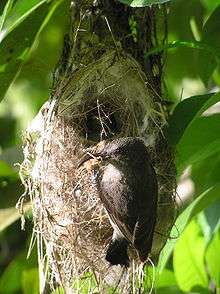
Order: Passeriformes Family: Nectariniidae
The sunbirds and spiderhunters are very small passerine birds which feed largely on nectar, although they will also take insects, especially when feeding young. Flight is fast and direct on their short wings. Most species can take nectar by hovering like a hummingbird, but usually perch to feed.
- Souimanga sunbird, Cinnyris sovimanga
- Seychelles sunbird, Cinnyris dussumieri (E)
White-eyes
Order: Passeriformes Family: Zosteropidae
The white-eyes are small and mostly undistinguished, their plumage above being generally some dull colour like greenish-olive, but some species have a white or bright yellow throat, breast or lower parts, and several have buff flanks. As their name suggests, many species have a white ring around each eye. There are 96 species worldwide and 3 species which occur in the Seychelles.
- Mayotte white-eye, Zosterops mayottensis (Ex)
- Madagascar white-eye, Zosterops maderaspatanus
- Seychelles white-eye, Zosterops modestus (E)
Old World orioles
Order: Passeriformes Family: Oriolidae
The Old World orioles are colourful passerine birds. They are not related to the New World orioles. There are 29 species worldwide and 1 species which occurs in the Seychelles.
- Eurasian golden oriole, Oriolus oriolus (A)
Shrikes
Order: Passeriformes Family: Laniidae
Shrikes are passerine birds known for their habit of catching other birds and small animals and impaling the uneaten portions of their bodies on thorns. A typical shrike's beak is hooked, like a bird of prey. There are 31 species worldwide and 3 species which occur in the Seychelles.
- Red-backed shrike, Lanius collurio (A)
- Lesser grey shrike, Lanius minor (A)
- Woodchat shrike, Lanius senator (A)
Drongos
Order: Passeriformes Family: Dicruridae
The drongos are mostly black or dark grey in colour, sometimes with metallic tints. They have long forked tails, and some Asian species have elaborate tail decorations. They have short legs and sit very upright when perched, like a shrike. They flycatch or take prey from the ground. There are 24 species worldwide and 1 species which occurs in the Seychelles.
- Aldabra drongo, Dicrurus aldabranus (E)
Crows, jays, ravens and magpies
Order: Passeriformes Family: Corvidae
The family Corvidae includes crows, ravens, jays, choughs, magpies, treepies, nutcrackers and ground jays. Corvids are above average in size among the Passeriformes, and some of the larger species show high levels of intelligence. There are 120 species worldwide and 2 species which occur in the Seychelles.
- House crow, Corvus splendens (I)
- Pied crow, Corvus albus
Starlings
Order: Passeriformes Family: Sturnidae
Starlings are small to medium-sized passerine birds. Their flight is strong and direct and they are very gregarious. Their preferred habitat is fairly open country. They eat insects and fruit. Plumage is typically dark with a metallic sheen. There are 125 species worldwide and 3 species which occur in the Seychelles.
- Common myna, Acridotheres tristis (I)
- Rosy starling, Pastor roseus (A)
- Wattled starling, Creatophora cinerea (A)
Weavers and allies
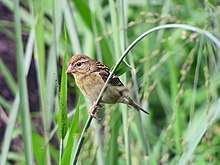
Order: Passeriformes Family: Ploceidae
The weavers are small passerine birds related to the finches. They are seed-eating birds with rounded conical bills. The males of many species are brightly coloured, usually in red or yellow and black, some species show variation in colour only in the breeding season. The status of the red fody in the Seychelles is uncertain, it was possibly introduced or may have been an uncommon resident prior to human arrival.
- Red fody, Foudia madagascariensis (I?)
- Aldabra fody, Foudia aldabrana (E)
- Seychelles fody, Foudia sechellarum (E)
Waxbills and allies
Order: Passeriformes Family: Estrildidae
The estrildid finches are small passerine birds of the Old World tropics and Australasia. They are gregarious and often colonial seed eaters with short thick but pointed bills. They are all similar in structure and habits, but have wide variation in plumage colours and patterns. There are 141 species worldwide and 1 species which occurs in the Seychelles.
- Common waxbill, Estrilda astrild (I)
Old World buntings
Order: Passeriformes Family: Emberizidae
The emberizids are a large family of passerine birds. They are seed-eating birds with distinctively shaped bills. Many emberizid species have distinctive head patterns.
- Ortolan bunting, Emberiza hortulana (A)
Finches, euphonias, and allies
Order: Passeriformes Family: Fringillidae
Finches are seed-eating passerine birds, that are small to moderately large and have a strong beak, usually conical and in some species very large. All have twelve tail feathers and nine primaries. These birds have a bouncing flight with alternating bouts of flapping and gliding on closed wings, and most sing well.
- Common rosefinch, Carpodacus erythrinus (A)
- Yellow-fronted canary, Crithagra mozambicus (I)
Old World sparrows
Order: Passeriformes Family: Passeridae
Old World sparrows are small passerine birds. In general, sparrows tend to be small, plump, brown or grey birds with short tails and short powerful beaks. Sparrows are seed eaters, but they also consume small insects.
- House sparrow, Passer domesticus (I)
See also
References
- Clements, James F. (2000). Birds of the World: a Checklist. Cornell University Press. p. 880. ISBN 0-934797-16-1.
- Lepage, Denis. "Checklist of birds of the Seychelles". Bird Checklists of the World. Avibase. Retrieved 27 April 2007.
- Seychelles Bird Records Committee (2012). "Seychelles Bird Records Committee: Species Checklist". Retrieved 14 June 2007.
- Skerrett, Adrian; Betts, Michael; Bullock, Ian; Fisher, David; Gerlach, Ron; Lucking, Rob; Phillips, John; Scott, Bob (2006). "Third report of the Seychelles Bird Records Committee". Retrieved 14 June 2007.
- Skerrett, Adrian; Bullock, Ian; Disley, Tony (2001). Birds of Seychelles. Christopher Helm. ISBN 0-7136-3973-3.
External links
- Birds of Seychelles - World Institute for Conservation and Environment
- Seychelles Bird Records Committee All birds recorded on the Seychelles list

